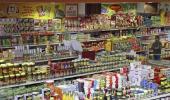'We've maintained that India is a high-penetration game. It's not only a premiumisation game.'

Tata Consumer expects strong double-digit growth to continue in Q1FY26.
In an exclusive interview, Sunil D'Souza, managing director and chief executive officer, talks to Sharleen D'Souza/Business Standard about the company's two acquisitions, consumption patterns and new targets.
Do you expect strong performance to continue in FY26?
We have guided for consistent double-digit top line growth and Ebitda (earnings before interest, tax, depreciation and amortisation) expansion this quarter.
Ebitda was under pressure this quarter. As the new tea crop comes, we continue to do graduated price increases.
We expect pressure on Ebitda margins in tea to go or lessen to a significant extent -- by the middle of Q2 because that is when the final crops will start hitting us.
Do you expect Capital Foods and Organic India to deliver strong growth?
For both the businesses we've said we will grow at least 30 per cent.
It took us four to five months to understand the two businesses because the buying cycle, marketing, the type of outlets, the weighted value of outlets, and supply chains were different.
While we integrated quickly, learning took a little bit of time, but now we are well on our way -- whether it is expanding distribution in Ching's or accelerating the pace of innovation, or doubling down on categories where we see an opportunity.
Like in differentiated noodles we see a good opportunity, in Schezwan Chutney also we see good opportunity.
We will start accelerating. In Organic India, there were two parts.
The first was half the business was India and the other half international. About 40 per cent of the total was the United States (US).
In the US, the hypothesis was Amazon. We've run a few trials on Amazon, and we are seeing good growth there. There is no reason why we can't continue.
How do you expect coffee prices to move and will the tariff war have any impact on the business?
I don't see any issues with our businesses, primarily because our big business in the US is coffee. The US doesn't produce coffee, and everyone imports it.
The good part is we've got manufacturing onshore, so we import the raw material and manufacture there.
There are a lot of competitors that manufacture it outside or pack it outside, and get it into the US.
From that perspective, we are at an advantage. It's not that there'll be a substantial difference.
Coffee prices have been going up because both robusta in Vietnam and Arabica in Brazil have some issues.
The day tariffs were announced, or within a week of tariffs being announced, coffee prices did drop a bit but again they started inching up.
We have stopped making forecasts about coffee. We've stopped doing long hedges on buying.
And we're buying short because we don't know how this would play out. I would stay close to the ground and make our moves as and when coffee prices move in either direction.
Urban consumption has been an issue in India for the past few quarters, but you've shown strong growth despite those. Do you see an overall recovery in urban consumption?
If I take the general trade alone, (our) rural has grown at about 7.2 per cent, and urban has grown close to 2 per cent.
But there have been substantial channel shifts. Ecommerce has come to the party, and so has quick commerce.
If I add back the modern trade, if I add back all of quick commerce because quick commerce is all urban, and I assume that 50 per cent of ecommerce is urban and 50 per cent is rural, my urban growth is 14.5 per cent.
I really don't understand slowdown in urban. We've maintained that India is a high-penetration game.
It's not only a premiumisation game. In many categories, even highly penetrated categories like tea and salt, branded penetration is still a significant opportunity.
India is a land of opportunities -- both on mass as well as premium. This way we have structured our portfolio and are driving execution across the board.
I think that is the key to delivering top line growth.
Do you have new targets in place to expand your distribution?
We service 2 million active outlets. And the numeric reach is about 4.4 million. There will be some increase, maybe 200,000-300,000 on the direct reach.
But we do expect a substantial increase on the numeric reach. I would say we would be targeting between 4.8 million and 5 million outlets on the numeric reach because we have distributors in all the more than 50,000 towns, and we will go down to 20,000 in some select markets.
The focus will be now to get beyond that. It will be the network of wholesalers, super stockists, and sub-distributors that will get us the numeric reach because for good companies, the wholesale multiplier is roughly two and a half to three.
If I have got 2 million, I should be getting close to 5 million outlets.
While we strengthen our brands and drive innovation, there's no reason why we can't continuously inch up towards that number.
Will look at further acquisitions?
Once we run out of ideas and the runway in food and beverages, we will look at fast-moving consumer goods. I think we've still got enough runway to grow food and beverages.
Right now, we focus on food and beverages. We've still got some work to do on Capital Foods and Organic India.
But yes, in the medium term, we remain focused on growing both organically and inorganically.
In the short term, we are focused on making sure we are delivering value against these two acquisitions we've done.
Feature Presentation: Aslam Hunani/Rediff.com











